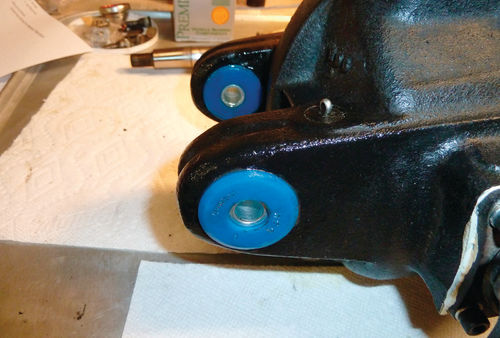Vintage Road Test Driving Two 1937 Grahams
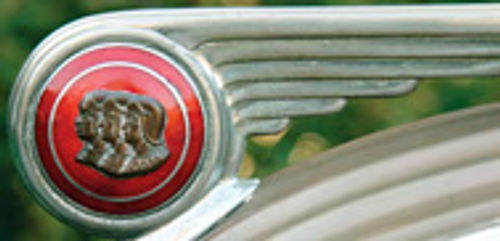
We Took a Supercharged Coupe and Sedan Out On the Road. That Extra Push Makes a Nice Drive Even Better.
SOME SAY TIMING is everything, and the Graham automobile proved it—unfortunately. Despite The Fact that the company made some great cars, they got into the auto business at the worst possible time. As a result, many of us have never seen a Graham or even heard of the marque. I had mainly seen Grahams in pictures until I spotted a 1937 Custom Supercharger at a restoration shop in Southern California, and then, incredibly, I encountered another from the same year at the Palos Verdes Concours d’Elegance.
I knew from photographs that many Graham models were quite beautiful, such as the 1932 Blue Streak and the 1940 Hollywood that used the Cord body dies; but other than that, I knew very little about them. Then I got a chance to drive the two aforementioned 1937 models. They were, perhaps, not the most attractive examples of the brand, but were certainly interesting and worthy machines.
Let’s Go For a Spin
The first 1937 Graham I discovered was a remarkably preserved original coupe and I Test-drove it first. Later I’ll tell you what it was like to drive the same car in sedan form, and fully restored. Each example had a lot to offer and yielded different insights.
As background on the vehicles, Graham product lines for 1937 included the Crusader, the junior series that looked different than the other Grahams sold that year. It had a 169-cubic-inch flathead six and rode on a 111-inch wheelbase.
The Cavalier had a normally aspirated 169-cubic-inch flathead six and a 116- inch wheelbase.
Next was the Supercharger(Series 116) that had a 199-cubic-inch supercharged flathead six and used the same 116-inch wheelbase.
Finally, there was the Custom Supercharger(Series 120)that had a 217-cubic inch supercharged flathead six but the same 116-inch wheelbase, unless you went for a stretched 120-inch version.
The Cavalier, Supercharger and Custom Supercharger were all the same basic car with the same look. The only things that were different between them were the engines and the superchargers. Both of the cars we tested were top-of the-line Custom Supercharger models.
Obviously, opportunities to drive such cars don’t come along often, so when I found the 1937 coupe at Chris Kidd’s Tired Iron restoration facility in Monrovia, California, I knew I had to finagle a drive in it if at all possible. Only two hundred of these top-of-the-line Grahams were produced that year. And this one was a remarkably original car with a few rough edges, but very presentable.
The thing that made Grahams such as the two I drove very special is that they sported an exciting feature no other mass-production car of the era had: They were the only ones equipped with a factory-installed supercharger at that time. Cord featured blowers briefly, as did a couple of other high-end custom-built brands, but they were only on a few of those cars.
Driving the Coupe
The little coupe had been part of a large collection of classics used for movie work that was being sold off, so I needed to act fast. Kidd—who was preparing the car for sale—made the necessary phone calls and got me a chance to take a spin in this remarkably preserved machine.
We then took the car into the hills behind his shop for a drive.

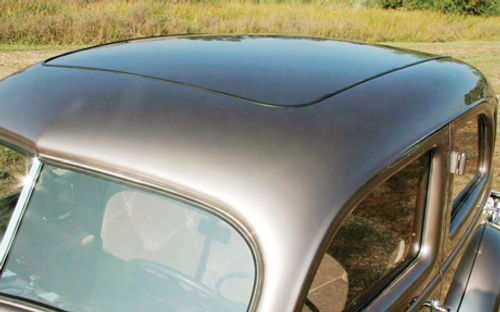
The Graham’s doors are large, and entry is easy. It’s not a big car, but there is plenty of head and legroom and the front seat is lounge-sofa comfortable. (There is no back seat. Also, the spare tire is stored behind the passenger side of the front seat.) There is a speedometer the size of a salad bowl, with a pool cue for a needle in front of the driver, and a full set of gauges in the center of the elegant art deco streamlined plastic center dash. The side panels and glove box are wood-grained in a rich mahogany. The car’s doors close with a solid click…even after 75 years.
I pull the manual choke out a little and step on the starter pedal. It seems as if the battery is almost dead at first because the engine barely turns over, but then it catches. This is also typical of many of the Graham’s contemporaries with 6-volt electrical systems. As the engine warms, I ease in the choke and it begins to idle smoothly. I depress the rather soft clutch and pull the floor-mounted shift lever into gear. We glide away from the curb and are off. There is the usual subtle first gear whine, but shifting is clean and precise.
Acceleration is surprising. Most moderate displacement inline six-cylinder flathead engines of the late ’30s are less than impressive in this respect, but when one judges the Graham against its contemporaries, it is quite a pleasant surprise. The little coupe is not in any way a muscle car, but it is no slug either.
The engine doesn’t run out of revs right away, unlike many cars of the era. The Graham-designed and manufactured supercharger is quiet and operates at all rpm, and the engine makes a fair amount of low-end torque, so there is power even from a standing start. Coupled with the optional electric overdrive available in 1937, this car could still hold its own on the highways of today.
The boost of the supercharger is only four to six pounds, yet it resulted in 116 horsepower from the 217.8-cubic-inch six. For the day, that was impressive. By comparison, the naturally aspirated 199- cubic-inch six in the Cavalier models was rated at 85 horsepower.
I am told that the supercharged model gets better fuel economy than the less- expensive carbureted engine as well, because the supercharger does a better job of atomizing the fuel for its journey down the long inline manifold runners.
The aluminum heads used on all the Graham engines of the era also dissipate heat better than the standard cast iron heads common to most cars of the time. This allows for a higher 7.5:1 compression ratio, giving the car a bit more oomph as well.
Steering is light and comfortable, and the ride is acceptable if a little choppy. The hydraulic brakes, with their 11-inch drums, are excellent for the period and do not fade on downhill runs. Also surprising is the fact that there is very little of the body lean so common to cars from the late 1930s. I attribute this to the car’s large anti-sway bar, modern aircraft tubular shock absorbers, and leaf springs mounted outboard of the frame.
The smell and feel of this 75-year-old Graham brings back a cascade of memories from my childhood. In the old cars of 50 years ago, the mohair upholstery had absorbed the smells of hot oil and water from the engine along with cigarette/cigar smoke from drivers, creating an unmistakable aroma. Also, there was the slight sound of mechanical tappets and creaking bolted-on body panels where the fender welt has dried out. Add to that the squeaks of old leaf springs, all reminiscent of my youth.
Driving the Sedan
I spotted the 120 Series four-door sedan at the Palos Verdes Concours recently, and had to take it out for a ride too. It is owned by Jim Wangers of Oceanside, California, a well-known ’60s-era drag racer and former marketing man who helped establish the GTO mystique. Understandably, Wangers also has an extensive collection of mostly ’60s Pontiacs and other muscle cars, some of which he raced. Robert Johnson, Wangers’ curator for the collection and a restoration veteran, did much of the finishing restoration work on this Graham.
While an original car such as the coupe can give you the sounds and smells of the old cars we remember from our childhoods, a freshly restored classic tells you just how nice a particular car was when it left the showroom, and this 1937 Graham 120 is no exception. The restored version of the car starts instantly, its engine settles into buttery smooth silence, and it accelerates briskly and smoothly from a stop. There is no rattling, no tappet noise, and the upholstery smells new.
Driving a restored 1930s mid-priced car tells you just how nice these cars were when their suspension and shock absorbers were fresh, their steering tight, and their engines fresh and balanced. Granted, they are geared a bit low for modern freeway speeds, but remember, the first freeway in the U.S. opened in 1940 in Pasadena, California. The speed limit on it was just 45 miles per hour, so the 1937 Graham was more than equal to the fastest roads of the day.
The sedan’s ride is not as choppy as the coupe, no doubt because of the better weight distribution of the sedan body. The back seat is as roomy as first-class airliner accommodations. There is all kinds of leg and headroom, and plenty of room for two people in comfort, or three if they are willing to be a little intimate. Visibility is reasonably good, though typical of cars of the era; the windows are a bit small.
In short, if I wanted what I perceive to be the most attractive Graham 120 of 1937 I’d choose the coupe. I have always loved the ’30s-era coupe styling. But if I were going out with friends on a tour, the sedan would be my choice. Of course, for less money you could have had a Cavalier 116 with a normally aspirated version of the same engine, but it would not be as much fun to drive.

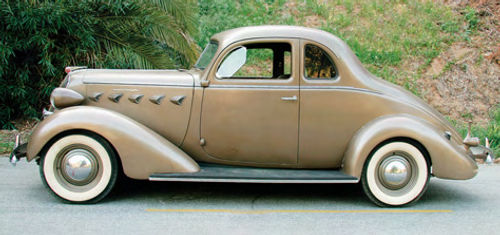
Hard Times for the Grahams
Because the Graham Custom Super- charger models for 1937 were the company’s top-of-the-line products, they came with some unique features, such as the aforementioned supercharger, a somewhat larger (217.8 cubic inches) engine with aluminum pistons and full- pressure lubrication to their thin-shell insert bearings. And they had well- designed, handsome interiors.
However, there were other features of the vehicle that, though still common practice at the time, were becoming a bit dated for a mid-priced car. The pedal starter, manual choke and solid front axle instead of independent front suspension were all features more common to low-priced vehicles of the time. Also, while GM had pioneered the one-piece Turret Top in 1936, the Graham sedans still had inserts, although they were made of steel. And wind wings—standard on many cars— were an extra cost option on Grahams.
But considering the fact that the Graham-Paige Motor Corp. had been struggling against a terrible lack of development funds for years, it was impressive that the company was still in business at all, much less able to build such a surprisingly decent car.
For 1936 and ’37 Graham’s bodywork was adapted from that of the 1936 Reo Flying Cloud body built by Hayes, for which Graham paid royalties to Reo of $7.50 per car. It also was about this time in 1937 that the dies, tools and fixtures for the company’s low-priced Crusader line were sold to Nissan in Japan.
The Reo bodies were adapted because Graham did not have the financial resources to restyle its line, which was looking a little dated by the mid-’30s. But then Reo collapsed soon after the deal was struck, leaving Graham with a contemporary, if not especially exciting new look. For 1937 the basic Reo body was treated to a new grille, two-piece wind-shield and a front end that was reminiscent of the 1936 Pontiac and the 1937 Plymouth. The overall effect was not revolutionary, but it at least looked up-to-date.
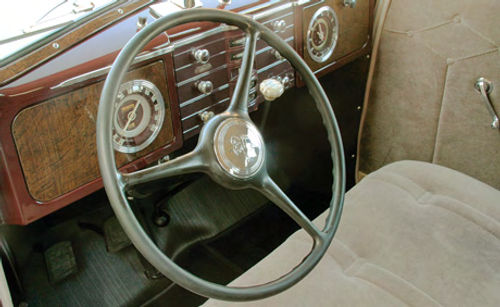
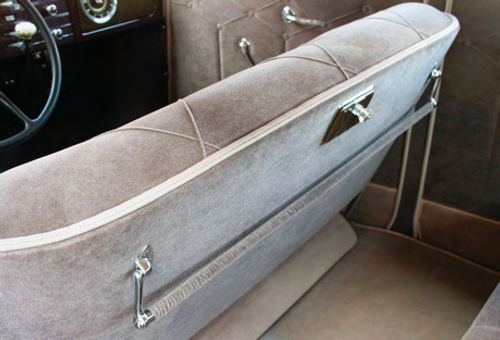
They Did Well With Bottles
There never was a shortage of business acumen at Graham; it was just that, as noted above, the company couldn’t have chosen a worse time to go into the automobile business. The Graham brothers, Joseph, Robert and Ray (the three cavaliers on the car’s badge) were very successful businessmen before they ever started building cars.
Back in 1901 Joseph Graham became secretary and treasurer of the Lythgoe Bottle Co. in Indiana. Then in 1905 Joseph and his father purchased the firm outright. In 1907 brother Robert joined the company and it was renamed the Graham Glass Co.
It was the Graham Glass Co. that developed the modern technique of pouring bottles upside down. This permitted the glass to build up around the crown, thus making the bottle strong enough to accept a cap instead of a cork. The Graham Glass Co. later became part of Libby-Owens-Ford (LOF). Around this time the brothers expanded into other ventures as well, including the manufacture of trucks.
A Start With Trucks
At first the Grahams offered kits to convert Ford Model T vehicles into pickups, but then they started producing their own brand using mostly Dodge Brothers components. These vehicles earned a good reputation and were soon offered at Dodge Brothers dealerships.
Things went well and the firm expanded from its initial plant in Evansville, Indiana, to another in Detroit and one in Stockton, California. In 1925, Dodge purchased the truck firm from the Graham Brothers.
The brothers stayed on for another year until Dodge was sold to Chrysler, and then decided to go into the auto manufacturing business on their own in 1927. For four million dollars they purchased the Paige-Detroit Motor Co.—an auto-manufacturing firm that had been in business since 1909. The brothers could easily afford to do this because along with the profitable truck operations, they had been involved in other successful ventures including farming and farm machinery.
They debuted an all-new line of cars for 1928 that offered both six- and eight- cylinder engines. And in February of that year they changed the name of the company to Graham-Paige Motor Corp. The new line was a success, and the company finished the year with sales of 72,965 cars, putting them twelfth in what was then a very crowded market. In fact, the cars continued to do well through 1929 when the second series was introduced.
Production facilities at their Warren St. plant were doubled in size, and the 50,000th Graham-Paige for that year was produced by June seventh. The future must have looked rosy indeed. Who could have guessed at that point that by the end of the year the automotive industry would be changed forever by the stock market crash and Great Depression to follow.
Graham survived the first year of the Depression even though 1352 banks failed, and unemployment climbed to nearly nine percent. By emphasizing their less-expensive models and by making judicious price cuts, the company man- aged to stay afloat, though in the red.
By the fall of 1930 the Graham Brothers had decided that the only way to return the company to profitability was to build a car that was all new and styled so compellingly that what was left of the buying public would be drawn in irresistibly.
Sales continued to languish during 1931 across the spectrum of automakers. But Graham devoted themselves to their new model to debut in 1932, later dubbed the Blue Streak. A new frame was developed that allowed the rear axle to protrude through the frame rails, thus lowering the center of gravity of the car. And the longitudinally mounted leaf springs were attached outboard of the frame, thus taking the car still lower and improving handling and body lean.
A new, improved power plant was developed from the company’s existing 245.4-cubic-inch inline eight, with five main bearings and improved crankcase ventilation. But the most innovative aspect of the new engine was its aluminum high- compression head that helped bump it up to 90 horsepower.
Amos E. North up at the Murray Corp.—a body manufacturer—headed a team that did the styling for the Blue Streak and it was one of the most beautiful designs of the era with its sloped back subtle V-shaped grille, skirted fenders that hid the mud spattered up behind the wheels by the dirt roads of the day, and its general low, clean classic profile. The new Graham line was also one of the first to use laminated safety glass thanks to the brothers’ interest in Libby Owen Glass Co.
Searching for a Better Body
The 1932 Graham Blue Streak was also the first production car offered with pearlescent paint schemes made from fish scales. The effect was startling, though impossible to do justice in the color advertising of the day. But even though the cars were major hits around the country, sales were discouraging. The country had hit bottom, and 20 percent of the workforce was jobless. Most people were more concerned with feeding their families than upgrading their transportation.
The Blue Streak influenced auto design for the next few years, but by 1935 the look was becoming dated. And Graham was hurting to the point where a restyle was out of the question. That is when they decided to share the Hayes bodies with Reo.
Sales continued to languish through 1937, and in 1938 the Cavaliers and Supercharger models received daringly restyled coachwork that Graham marketed as the Spirit of Motion, which became known to the general public as the shark nose Grahams. The front end had an extravagant buxom Delahaye look with lots of chrome, but the rest of the car had a sort of blocky appearance.
It was Amos Northup’s last auto design, as he died shortly after completing it. The new look—which was carried over into 1939 and 1940—was not a success, no doubt partly because 1938 was a recession year. Again, it may have been a matter of timing.
Both Hupmobile and Graham needed new styling in order to stay afloat by 1939, so when the magnificent mid-’30s body dies from the now-defunct Cord became available, they jumped at the chance to partner up and build new cars using adaptations of their own, called the Hupmobile Skylark and the Graham Hollywood. Some things had to be re-engineered to accommodate Hupmobile’s and Graham’s inline engines and rear-wheel drive though.


These turned out to be some of the most beautiful cars either company ever made, but there were major production problems. The Hups and Grahams had unitized bodies, and were built on the same line as Graham’s Special which still had the old Spirit of Motion styling and used a separate frame. As a result, there was a lot of confusion. Also, the Cord bodies had very complex top stampings that slowed production considerably.
Exits From the Auto Business
Hupmobile folded in 1940, and Graham-Paige quit making cars in 1941, but the company stayed in business. War work was abundant, and farm machinery was still being made.
After the war, the last president of Graham-Paige—Joe Frazer—started building his own line of cars at the Graham-Paige plant. And then Henry J. Kaiser bought into the company and they began to make the Kaiser automobile as well.
But as the saying goes, that’s another story.
















